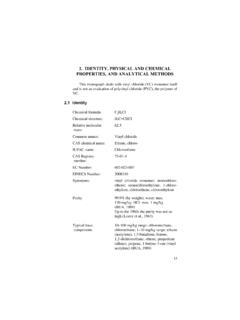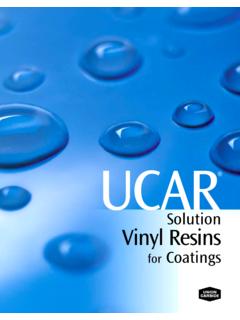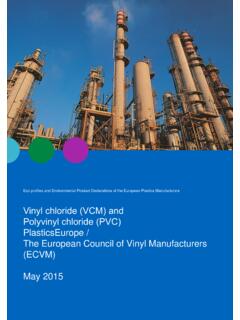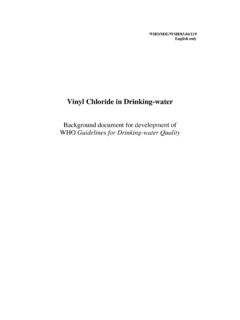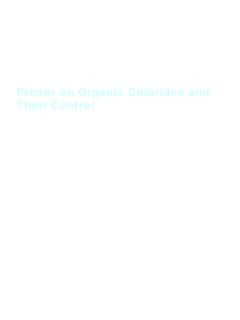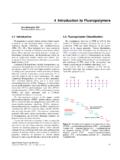Transcription of STABILIZATION of POLYVINYL CHLORIDE - Gila …
1 STABILIZATION of POLYVINYL CHLORIDE OPTIMUM STABILIZER SELECTION George A. (Skip) Thacker The process of recommending an optimum stabilizer for a particular vinyl application, then selecting and evaluating that stabilizer, can be a formidable task. This is especially due to the vast numbers of stabilizers which are marketed to the PVC industry world-wide. There are many well regarded stabilizer producers in North America, Europe, and the Far East, as well as many more producers in Latin America and India. Most of these offer many commercially available stabilizers in their product lines, some in the dozens! One reason so many stabilizers are offered to vinyl compounders is that the PVC compounding industry has become more astute and sophisticated over the years, requiring development of stabilizers to fill many specific requirements other than simply to provide process heat stability for PVC compounds.
2 Another reason for the large selection of stabilizers centers on the wide diversity of vinyl applications and methods of processing. PVC is truly the most versatile of all polymers! The total Heat/Shear History of vinyl compounds can vary significantly in both amount and type among different applications. This concept of Heat History and The total capacity of the stabilizer system to furnish the required protection is perhaps an over-simplified way of integrating the total energy input of all types to which a vinyl compound is subjected over a product s useful life span. The shear and heat energy of mixing cycles (dryblend, banbury, high speed plastisol dispersators), processing (calender, extruder, molder), fabricating (embossing, thermoforming, laminating ), scrap re-work, heat and light energy of outdoor exposure, heat of a product s use environment (auto interior, hot air duct) , Gamma ray sterilization, and other end-use requirements-- all contribute to overall PVC degradation.
3 The stabilizer system must be able to furnish adequate protection at every stage during the production and useful service life of the vinyl product. The amount and type of energy input varies considerably among the many different production methods and end-use applications of PVC. Also, the accumulated storage history of PVC resins before compounding can vary. Resin degradation actually starts in the polymerization reactor and can continue under storage conditions through oxidation, carbonyl formation, etc. even before use. The purpose of this discussion is to present a logical sequence of factors to consider in selecting a stabilizer, in order to provide a practical means first to select a generic group or class of stabilizers, and secondly to choose a specific stabilizer within the class to fully optimize the selection.
4 Theoretical discussion of PVC STABILIZATION and chemical mechanisms offered to explain the hows and whys of stabilizer behavior will not be presented in this treatise. GENERAL STABILIZER GROUPS There are several basic groups of heat and light stabilizers currently offered to the vinyl industry: 1)- Mixed metal-organic acid salts (liquid and solid), consisting of any one or a combination of Barium, Calcium, Cadmium(disappearing), and Zinc. Typically, C8 to C18 straight chain or branched chain aliphatic carboxylic acids are used. Aromatic ( alkyl benzoic) acids once used are no longer in favor due to toxicity concerns. 2)- Organotin compounds (liquid and solid), mainly mercaptoester and mercapto alcohol types (sulfur-containing), and carboxylate or dicarboxylate (non-sulfur) ester types. 3)- Lead salts and soaps (liquid and solid) 4)- Calcium-Zinc carboxylate packages (liquid, paste, powder) containing USFDA/BGA sanctioned ingredients for nontoxic applications.
5 5)- Organic and miscellaneous types, including alkyl/aryl phosphites, epoxy compounds, beta-diketones, amino crotonates, nitrogen heterocyclic compounds, organosulfur compounds ( ester thiols), hindered phenolics, and polyols(pentaerythritols). These types currently are being heavily researched, and their use at the expense of metal-containing stabilizers is expected to grow significantly. 6)- A minor group consisting of carboxylic or mercaptoester salts of antimony, strontium, potassium. Generally speaking, flexible vinyl compounds which are calendered, extruded, or molded and plastisol compounds most commonly are stabilized with (1) the mixed metal Ba/Zn, Ca/Zn systems. Applications requiring USFDA or BGA sanction for direct or indirect food contact and most medical applications utilize the (4) non-toxic Ca/Zn systems.
6 Rigid vinyl compounds for extrusion and molding are stabilized most frequently with (2)organotin mercaptides in North and South America, and parts of the Far East, and (3)Lead or(1) Mixed Metal systems in Europe. Flexible vinyl compounds used in electrical wire coating applications are mostly (3) Lead stabilized, since leads offer the best electrical properties - due primarily to the insolubility of lead chlorides formed during STABILIZATION . Currently lead is under pressure for possible replacement by special mixed metal systems, in secondary and decorative wire insulation. However, primary insulation is still best stabilized by lead. FACTORS GOVERNING OPTIMUM STABILIZER SELECTION The factors to consider in making an optimum stabilizer selection for a given vinyl process can be divided into three broad categories: Formulation Variables Process Variables End-use Properties Formulation variables such as PVC resin, impact modifying resins, processing aids, plasticizers, fillers, pigments, lubricants, foaming agents, and other miscellaneous ingredients can all have an effect upon or be affected by the stabilizer.
7 Process Variables which can be a determinant in stabilizer selection include consideration of compounding procedures (Banbury, Dryblend, Plastisol Mixing), calendering,extrusion (single or twin screw), injection molding, blow molding, coating molding or dipping of plastisols and organosols, solution vinyl systems, foamed vinyls and fluidized bed powder coating. Other considerations of processing include melt rheology, plastisol viscosity properties, plate-out, scrap re-work, etc. End Use Properties that affect stabilizer selection include clarity, outdoor weathering, toxicity, stain resistance (sulfide, urethane, asphalt), impact strength, heat distortion, electrical properties, odor, effects of moisture (haze, dimensional stability), heat-sealing and printability, and fogging (automotive and food wrap film). FORMULATION VARIABLES : vinyl Resins - The wide variety of differing types of PVC resins which require STABILIZATION , and the large number of resins available within each variety probably is the single greatest factor which explains the large number of commercially available stabilizers confronting the vinyl compounder.
8 PVC homopolymer is produced by suspension, bulk (or mass), and emulsion polymerization methods. The amount and type of residual components on the resin shipped to users (catalyst residues, suspension agents, emulsifying agents, etc.) can differ to the extent that even vinyl resins manufactured by the same polymerization method from different producers can vary in their response to a given stabilizer system. Moreover, since the vinyl CHLORIDE Monomer crisis of the early 1970 s, efforts to reduce residual VCM by steam-stripping and more rigorous drying procedures added another dimension to resin variability since no two producers techniques were identical. Pink , or off-white PVC sometimes found its way to customers--- especially during tight supply periods! Post-chlorinated PVC (High Temp.), with a very narrow processing window offers additional STABILIZATION challenges.
9 vinyl acetate- vinyl CHLORIDE copolymers and vinyl CHLORIDE with other co-monomers (propylene, cetyl vinyl ether, vinylidene CHLORIDE ) also differ widely in their response to a given stabilizer system. One of the most striking differences in stabilizer response occurs with mixed metal Ba/Zn, Ca/Zn, and (formerly) Ba/Cd/Zn stabilized formulations. This phenomenon is known as Zinc Sensitivity , and is seen as a drastic discoloration- even burning- in PVC compounds subjected to progressive exposure to heat. PVC resins can vary considerably in their response to varying zinc levels of a stabilizer system. Years ago, most then commercially available vinyl resins were classified as to Zinc Sensitivity , in addition to the ASTM D-1755-60T (1960) cell classification covering other resin properties. This classification unfortunately has fallen by the wayside over the ensuing years, but is still a viable tool for the astute compounder.
10 In the figures, Zinc Sensitivity , we see the different response of four PVC resins, each stabilized with a series of three Ba/Cd systems differing only in the level of Zn, and exposed in an oven at 350 for an increasing number of 10 minute intervals. PVC resin A exhibits slight improvement as the zinc content is increased, and we see that the presence of zinc in the stabilizing system for this resin is beneficial. The stability of resin B is neither enhanced nor materially retarded with increasing levels of zinc. Stability of resin C is moderately affected by increasing zinc levels of the stabilizer system, while resin D is extremely sensitive to the presence of even small quantities of zinc. Many vinyl acetate/ vinyl CHLORIDE copolymers are extremely zinc sensitive and would be comparable to resin D. In fact, the zinc sensitivity of a vinyl acetate/ vinyl CHLORIDE copolymer is directly proportional to the vinyl acetate content of the copolymer.


